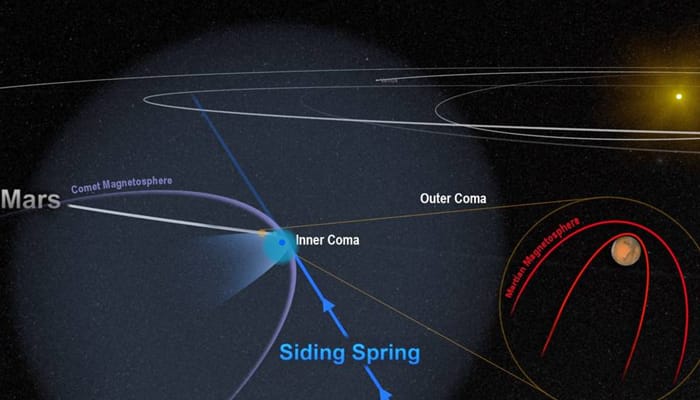Washington: Data from NASA's Mars Atmosphere and Volatile Evolution (MAVEN) spacecraft has revealed that the flyby of comet C/2013 A1 (Siding Spring) with Mars in October 2014, impacted the magnetic field of the Red Planet.
To protect possible harm from the flyby, NASA turned off some instruments of MAVEN and other Mars orbiters.
But MAVEN’s magnetometer, which remained on conducting observations from a front-row seat during the comet’s remarkably close flyby, gave scientists the 'one-of-a-kind' opportunity to view the havoc that the comet’s passing can cause on the magnetic environment, or magnetosphere, around Mars.
MAVEN’s sensitive magnetometer - located about 100 miles above the planet's surface - showed that the comet flyby threw Mars' magnetic field into chaos and the effect was profound although temporary.
"Comet 'Siding Spring' plunged the magnetic field around Mars into chaos. We think the encounter blew away part of Mars' upper atmosphere, much like a strong solar storm would,” said Jared Espley, a MAVEN science team member at NASA's Goddard Space Flight Center in Greenbelt, Maryland.
Unlike Earth, Mars is not shielded by a strong magnetosphere generated within the planet.
When comet “Siding Spring” passed Mars, the two bodies came within about 140,000 kms of each other.
During flyby, the comet's coma (envelope of gas flowing from a comet's nucleus as it is heated by the Sun) washed over the planet for several hours, with the dense inner coma reaching, or nearly reaching, the surface.
Mars was flooded with an invisible tide of charged particles from the coma and the powerful magnetic field around the comet temporarily merged with -- and overwhelmed -- the planet's own weak one.
“The main action took place during the comet's closest approach but the planet's magnetosphere began to feel some effects as soon as it entered the outer edge of the comet's coma,” said Espley.
By the time of closest approach -- when the plasma from the comet was densest -- Mars' magnetic field was in complete chaos.
Even hours after the comet's departure, some disruption continued to be measured.
Espley and colleagues think the effects of the plasma tide were similar to those of a strong but short-lived solar storm.
“With MAVEN, we're trying to understand how the sun and solar wind interact with Mars," added Bruce Jakosky, MAVEN's principal investigator from the University of Colorado.
By looking at how the magnetospheres of the comet and of Mars interact with each other, we're getting a better understanding of the detailed processes that control each one, the authors noted.
The findings were published in the journal Geophysical Research Letters.
(With Agency inputs)
















